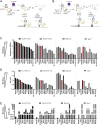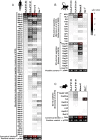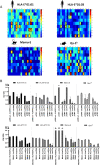Peptide Binding to HLA-E Molecules in Humans, Nonhuman Primates, and Mice Reveals Unique Binding Peptides but Remarkably Conserved Anchor Residues
- PMID: 33020145
- PMCID: PMC7653511
- DOI: 10.4049/jimmunol.2000810
Peptide Binding to HLA-E Molecules in Humans, Nonhuman Primates, and Mice Reveals Unique Binding Peptides but Remarkably Conserved Anchor Residues
Abstract
Ag presentation via the nonclassical MHC class Ib molecule HLA-E, with nearly complete identity between the two alleles expressed in humans, HLA-E*01:01 and HLA-E*01:03, can lead to the activation of unconventional T cells in humans. Despite this virtual genetic monomorphism, differences in peptide repertoires binding to the two allelic variants have been reported. To further dissect and compare peptide binding to HLA-E*01:01 and HLA-E*01:03, we used an UV-mediated peptide exchange binding assay and an HPLC-based competition binding assay. In addition, we investigated binding of these same peptides to Mamu-E, the nonhuman primate homologue of human HLA-E, and to the HLA-E-like molecule Qa-1b in mice. We next exploited the differences and homologies in the peptide binding pockets of these four molecules to identify allele specific as well as common features of peptide binding motifs across species. Our results reveal differences in peptide binding preferences and intensities for each human HLA-E variant compared with Mamu-E and Qa-1b Using extended peptide libraries, we identified and refined the peptide binding motifs for each of the four molecules and found that they share main anchor positions, evidenced by conserved amino acid preferences across the four HLA-E molecules studied. In addition, we also identified differences in peptide binding motifs, which could explain the observed variations in peptide binding preferences and affinities for each of the four HLA-E-like molecules. Our results could help with guiding the selection of candidate pathogen-derived peptides with the capacity to target HLA-E-restricted T cells that could be mobilized in vaccination and immunotherapeutic strategies.
Copyright © 2020 by The American Association of Immunologists, Inc.
Conflict of interest statement
The authors have no financial conflicts of interest.
Figures






Similar articles
-
Conserved MHC class I peptide binding motif between humans and rhesus macaques.J Immunol. 2000 Jan 1;164(1):283-91. doi: 10.4049/jimmunol.164.1.283. J Immunol. 2000. PMID: 10605022
-
Analysis of HLA-E peptide-binding specificity and contact residues in bound peptide required for recognition by CD94/NKG2.J Immunol. 2003 Aug 1;171(3):1369-75. doi: 10.4049/jimmunol.171.3.1369. J Immunol. 2003. PMID: 12874227
-
The Role of MHC-E in T Cell Immunity Is Conserved among Humans, Rhesus Macaques, and Cynomolgus Macaques.J Immunol. 2018 Jan 1;200(1):49-60. doi: 10.4049/jimmunol.1700841. Epub 2017 Nov 17. J Immunol. 2018. PMID: 29150562 Free PMC article.
-
Class I MHC-peptide interaction: structural and functional aspects.Behring Inst Mitt. 1994 Jul;(94):48-60. Behring Inst Mitt. 1994. PMID: 7998914 Review.
-
Gorillas with spondyloarthropathies express an MHC class I molecule with only limited sequence similarity to HLA-B27 that binds peptides with arginine at P2.J Immunol. 2001 Mar 1;166(5):3334-44. doi: 10.4049/jimmunol.166.5.3334. J Immunol. 2001. PMID: 11207289 Review.
Cited by
-
HLA-E/peptide complexes differentially interact with NKG2A/CD94 and T cell receptors.J Immunol. 2025 Apr 1;214(4):595-605. doi: 10.1093/jimmun/vkae068. J Immunol. 2025. PMID: 40085431 Free PMC article.
-
Identification of HLA-E Binding Mycobacterium tuberculosis-Derived Epitopes through Improved Prediction Models.J Immunol. 2022 Oct 15;209(8):1555-1565. doi: 10.4049/jimmunol.2200122. Epub 2022 Sep 12. J Immunol. 2022. PMID: 36096642 Free PMC article.
-
The role of donor-unrestricted T-cells, innate lymphoid cells, and NK cells in anti-mycobacterial immunity.Immunol Rev. 2021 May;301(1):30-47. doi: 10.1111/imr.12948. Epub 2021 Feb 2. Immunol Rev. 2021. PMID: 33529407 Free PMC article. Review.
-
Instability of the HLA-E peptidome of HIV presents a major barrier to therapeutic targeting.Mol Ther. 2024 Mar 6;32(3):678-688. doi: 10.1016/j.ymthe.2024.01.010. Epub 2024 Jan 12. Mol Ther. 2024. PMID: 38219014 Free PMC article.
-
CD8+ T cell targeting of tumor antigens presented by HLA-E.Sci Adv. 2024 May 10;10(19):eadm7515. doi: 10.1126/sciadv.adm7515. Epub 2024 May 10. Sci Adv. 2024. PMID: 38728394 Free PMC article.
References
-
- Joosten S. A., Ottenhoff T. H. M., Lewinsohn D. M., Hoft D. F., Moody D. B., Seshadri C., Collaboration for Tuberculosis Vaccine Discovery - Donor-Unrestricted T-cells Working Group, Bill and Melinda Gates Foundation 2019. Harnessing donor unrestricted T-cells for new vaccines against tuberculosis. Vaccine 37: 3022–3030. - PMC - PubMed
-
- Geraghty D. E., Stockschleader M., Ishitani A., Hansen J. A. 1992. Polymorphism at the HLA-E locus predates most HLA-A and -B polymorphism. Hum. Immunol. 33: 174–184. - PubMed
-
- Braud V. M., Allan D. S., O’Callaghan C. A., Söderström K., D’Andrea A., Ogg G. S., Lazetic S., Young N. T., Bell J. I., Phillips J. H., et al. 1998. HLA-E binds to natural killer cell receptors CD94/NKG2A, B and C. Nature 391: 795–799. - PubMed
Publication types
MeSH terms
Substances
Grants and funding
LinkOut - more resources
Full Text Sources
Other Literature Sources
Molecular Biology Databases
Research Materials

